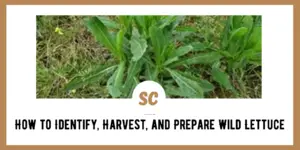Foraging is as much an art as it is a science. You must know and understand the plants in your area that are safe and nutritious to eat. Making a mistake about which plants are edible can, at best, leave you with an inedible mess. At worst, you can jeopardize your life. Fortunately, the abundance of wild lettuces and edible greens gives you plenty of options from which to choose while foraging.
True wild lettuce (Lactuca Virosa) is a biennial plant that occurs in various parts of North America and coastal Britain. Wild lettuce is widespread across central and southern Europe as well. Other common wild lettuce varieties in the U.S. include Lactuca Canadensis, Lactuca Ludoviciana, and Lactuca Floridana. In Europe, you can also find Lactuca Serriola. Lactuca Quercina is found in Eurasia.
In general, wild lettuce varieties have been used more as medicinal herbs than as staple food sources. Wild lettuces are sometimes used to treat various medical ailments, such as analgesics, and as a sleep aid.
However, before you start foraging wild lettuce, you should study examples, photos, and understand the possible side effects wild lettuce may produce when ingested. Many wild lettuce look-alikes can cause misidentifications.
Note: Some types of wild lettuce are called milk thistle or sow thistle.
Lactuca Virosa
Depending on your location, the wild lettuce variety Lactuca Virosa may be known by different names. You may hear the terms bitter lettuce, opium lettuce, prickly lettuce, tall lettuce, or great lettuce from locals knowledgeable about local varieties of edible and medicinal plants.
Folklore identifies Lactuca Virosa as having a mild analgesic effect and may produce sedative-like results in some people.
How to Identify Lactuca Virosa
As you might expect, Lactuca Virosa grows wild. The plant typically has bright green leaves. When mature, the plants can stand from two to seven feet tall (200 cm).
The plant may be covered by a whitish or yellowish flower when in bloom. An erect stem protrudes upward from the base in most cases. The base of the stem may have small hair-like structures attached.
The leaves have been described as “clasping” and have a long oblong shape, almost like the head of a lance. The edges of the leaves are finely toothed and can have fine spiny bristles along the underside of the leaf midrib.
How to Harvest Lactuca Virosa
To get the best results from Lactusa Virosa, the plants should not be harvested until the stalks and flowers have fully formed.
What you want from this herb for medicinal purposes is the white milky sap. The mature flower stalks will provide the most abundant harvest. Cut the stalks and allows the sap to drain into a container where it can be used as an analgesic and a sleep aid.
To eat Lactuca Virosa, you should harvest the young and tender leaves from the rosette that form as the plant grows. Be aware that even the young leaves can have a bitter taste that is not palatable to many people. The leaves become tough and fibrous as the plant matures, rendering them almost inedible.
Medicinal Uses
Lactuca Virosa is more widely used as a medicinal herb than as a food source. Much of this stems from the bitterness of the plant. However, many people swear to the efficacy of this wild lettuce as an analgesic and as an aid to sleep. This is why this wild lettuce is often called opium lettuce.
The milky white sap of wild lettuces are said to act as natural remedies for joint pain, chronic pain, and to act on the central nervous system to help with sleep disorders
Food Uses
As a food source, the young tender leaves of this wild lettuce plant can be eaten raw in a salad or cooked with other foods. Young leaves tend not to be as bitter or chewy as older leaves and stalks.
Many people like the slight bitterness the young leaves of Lactuca Virosa bring to a salad mix of other lettuce varieties and greens.
Lactuca Ludoviciana
This variety of wild lettuce plants may be even more widespread than Lactuca Virosa in the Western and Northern United States. This plant is routinely found in Western Canada, as far south and west as California, into Texas and Louisiana.
The Great Plains regions of the U.S. have large populations of this wild lettuce. Hence, one popular name for this wild lettuce is Western Wild Lettuce.
How to Identify Lactuca Ludoviciana
The leaves of Lactuca Ludovciana are usually green to blue-green when they are mature. The leaves may have some prickles along the edges and on the midrib along the underside of the leaves.
The stems of this plant a hairless and unbranched. The flowers will form clusters with short branches. Flowers are typically yellowish. When broken or scored, the leaves, stems, and roots will exude a brownish sap. The plants may reach a mature height of five feet.
The leaves of Lactuca Ludoviciana are variable and may not be a good identifier. The leaves can be up to twelve inches long and eight inches wide.
These large leaves feature deep lobes with a coarsely toothed perimeter showing sharp points. On most plants, the leaves have no stalks.
How to Harvest Lactuca Ludoviciana
If you intend to use Lactuca Ludoviciana as a medicinal herb, you should wait until the plants mature and start to flower. At this stage, the plants are at their peak of medicinal qualities. The goal is to produce a wild lettuce extract from the brown milky sap the plant exudes with broken stems or mature leaves scored lightly.
In some areas, the roots of Lactuca Ludoviciana are harvested and prepared in various ways. In practice, only the young tender roots are used for cooking. These are typically smaller than and lighter colored soft roots found toward the end of the root structure. You should look for the white taproot to find the best and most tender roots.
The leaves and stems of Lactuca Ludoviciana are also often used to brew a tea that will deliver some of the medicinal properties of the wild lettuce plant.
Medicinal Uses
The sap of these wild lettuce plants contains the substance “lactucarium.” Anecdotal reports indicate that some health benefits could come from this sap. It has been used to treat digestive distress as a hypnotic and has sedative properties causing drowsiness.
However, if used to excess, some reports indicate that restlessness may result. In extreme cases, cardiac paralysis and death have been reported.
Food Uses
When consumed as a foraged food source, the most common parts of the plant used are the young, tender leaves.
As the plant matures, the amount of sap in the stems and leaves increases, raising the bitterness. In addition, older mature leaves and stems can become woody, making them almost inedible. The young leaves can be eaten raw or cooked like any green.
Lactuca Floridana
Often called woodland lettuce, Lactuca Floridana is found in many of the same ranges as other species of North American Lactuca.
These plants may, in some cases, hybridize with other Lactuca plants in the area and may be almost indistinguishable from the other members of this relative of the dandelion flowers.
How to Identify Lactuca Floridana
Like most other false lettuces, Lactuca Floridana grows upwards from a central cluster of leaves producing stalks that can reach six feet in height.
The leaves cluster along the stalks without producing stalks of their own. A cluster of multibranched flower heads typically tops each stalk of the plant. Each flowering head may produce between ten and twenty blue or white florets.
How to Harvest Lactuda Floridana
Like any other wild lettuce, how to harvest Lactuda Floridana depends on how you intend to use the plant and the time of year. The sap contains the highest active ingredient levels for medical purposes that produce the sought results. If you intend to eat wild lettuce, harvesting the young leaves early in the season is the best choice to avoid the bitterness accompanying mature plants.
Medicinal Uses
Like most wild lettuce plants, Lactuda Floridana contains compounds that may have medicinal uses.
Traditionally, the sap is collected and reduced or dried. The reduced or dried sap treats insomnia, digestive upsets, and offers pain relief. Some practitioners also create poultices with stems and leaves to apply topically for bruises and to help relieve pain.
Food Uses
Wild lettuce, such as Lactuda Floridana, is best eaten when the plants are young and tender. The amount of sap in the leaves is much less when they are young, reducing the bitterness. Some people use the leaves to make herbal tea. In any case, the medicinal effects are usually much less than using the sap.
Other Forms of Wild Lettuce
Due to the purported medicinal advantages of wild lettuce, some herbal supplement companies are now producing wild lettuce supplements that can be purchased in tablet form.
Most of these supplements are produced from raw wild lettuce and packaged for retail sale. Some companies are also producing wild lettuce extract that can be used for making home remedies.
Does Wild Lettuce Have Medicinal Qualities?
There is a lot of debate about this question. There is no doubt that the active ingredient in wild lettuce sap does have some mild physical effects. However, the potency and quality of the plant material are always suspect. Wild lettuce is not subject to the agricultural controls that ensure the quality of the end product.
Many people claim wild lettuce has pain-relieving properties. However, many physicians and clinicians dispute these claims. These professionals believe that most of the pain relief effect people experience when using wild lettuce or its extracts are purely a placebo effect they bring on themselves. There are no evidence-based or laboratory studies to confirm the beneficial effects of wild lettuce.














![Lights Out Kit, Preparedness Levels, & WWIII [PODCAST] Lights Out Kit, Preparedness Levels, & WWIII [PODCAST]](https://survivalcove.com/wp-content/uploads/2021/11/survival-preppers-podcast-banner-370x297.jpg)






















